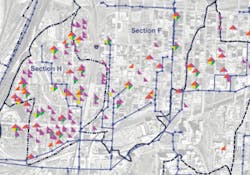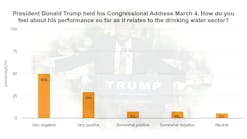by Paul Ginther
What do a city engineer, a backhoe operator, and a pizza delivery person have in common? They all need “location” information.
Keeping tabular information in a database, a spreadsheet, or hardcopy records has long been standard practice. Knowing the street address for facilities, customers, or work orders provides a general “where” factor.
However, tabular data tied to an address is generally not sufficient in the utility business. Geographic Information System (GIS) technology has added an entirely new level of functionality - and opened the world up to a wealth of information.
GIS is in use in almost every industry. People use it every day whether they realize it or not. Obtaining driving directions from the airport to a hotel uses a form of GIS that relates addresses to street networks and traffic patterns. Obtaining an Internet list of nearby restaurants of a specific type uses a GIS search function to query business data associated with geographic locations within a user-defined radius.
GIS maps can be used to display locations of complaints regarding water in basements and street flooding.
There are many advantages to using GIS in the utility business. Eighty to 90 percent of a utility’s data is somehow tied to a geographic location. Utilities must know where their pipes, valves, pumps, meters and other facilities are located. They also need to know the location and water usage patterns of their customers. And they need to know where their crews are working and what facilities need maintenance. GIS allows users to query and analyze information based on its location and its spatial relationship to other features-often where no other relationship is available.
Utilities typically maintain numerous databases that have been developed independently over many years. By relating shared locations, these otherwise unrelated data sets can be associated. As an example, GIS applications can help identify trends in water main breaks to prioritize pipe replacement and rehabilitation projects. Such projects are typically analyzed using a variety of weighted criteria such as pipe material, diameter, age, surrounding soil conditions, proximity to critical locations (such as hospitals and schools), main-break history, water quality, and coordination with other public works projects. These criteria can be represented spatially in a GIS and associated with the pipe inventory. Utilities can then decide not only what improvements to make but also when to best make those improvements.
The most obvious use for GIS is to record and analyze current conditions. The digital representation of a water or wastewater utility’s network typically includes pipes, meters, valves, manholes, and other critical facilities referenced to some sort of land base background of streets, parcels, contours, and political boundaries. This as-built picture provides the what, where, and when of the utility’s history. However, the same data are extremely useful in looking forward - especially when integrating the GIS with other data sets and applications.
Once established, a GIS can be enhanced to serve as a critical link for meeting ongoing data maintenance requirements, supporting numerous data analysis/reporting activities, and interfacing with other applications. A few examples are described below.
Integration with Hydraulic/Hydrologic Modeling
Hydraulic and hydrologic (H/H) modeling is commonly used to analyze water and sewer utility networks - especially for developing master plans and capital improvement plans. This modeling activity can help utilities evaluate system performance and identify improvements necessary for such parameters as meeting water pressure requirements or reducing water-in-basement problems.
GIS main break analysis can support pipe replacement prioritization.
Although much of the data needed for modeling can be maintained within a GIS, modeling and GIS have historically developed along separate but parallel paths. The primary goal for a GIS analyst typically has been to create a geographically accurate and up-to-date depiction of the actual utility system - the more detail, the better. The main objective for a modeler has been to create a hydraulically correct representation of the network, under various operating conditions, that would support flow/pressure modeling analysis - the simpler, the better. Historically, creating new H/H models has required tedious and costly data collection and model construction efforts, often duplicating work already performed in the creation of the GIS or previous models.
Recent advancements in software and database functionality have dramatically narrowed the gap between these two powerful applications. When properly designed, a GIS can now be used to efficiently develop the majority of an H/H model. Data cleanup and integrity tools streamline the effort to establish required network connectivity and verify correct network construction - such as preventing a 4-inch pipe from being inserted into the middle of a 24-inch pipe.
Additional benefits can be achieved by maintaining connectivity between the model and GIS. This integration significantly improves the ability to update or enhance future modeling efforts. Use of the advanced spatial analysis capabilities of GIS can further enhance modeling results. Examples include:
• Fire Flow Analysis. Most hydraulic modeling software can calculate available flow values at nodes throughout the system network. Different land-use categories have different fire flow requirements. Associating model results with land-use requirements in GIS enables users to evaluate the ability of a distribution system to meet fire flow requirements for various land uses. This information is useful for planning distribution system improvements to provide adequate fire protection.
This analysis can be taken to a higher level by using risk analysis tools to assign risk factor ratings to specific land uses (e.g., hospitals, schools, tall buildings). Specific fire risks can be determined by using GIS to overlay these ratings with the fire flow data. This analysis can help determine or support a city’s ISO (Insurance Services Office) rating.
• Drinking Water Source Analysis. Utilities that obtain water from multiple sources need a good understanding of how the water mixes throughout the network. This is especially important where source quality varies. Customers may want to know which source provides their water. However, over time a customer may be served from a number of sources, and the proportional mix of the various sources may be constantly changing. A long-term proportional (or percentage) mix of source water is a good indication of overall customer water quality.
For a specific operating scenario, the hydraulic model can be used to calculate the percentage of total demand supplied by each water source at any location in the distribution system. Using the GIS, percentage contours can be generated for each source. Overlaying this data onto a digital street or parcel map can help users correlate street addresses with source percentage polygons to determine the approximate percentage of water each customer gets from each source.
• Water Usage Demand Allocation. To accurately model a water distribution network, engineers must understand where water is being consumed under a variety of water usage conditions. Demand allocation is a process in which current or predicted future water consumption data is assigned to locations in the network. Ideally, existing water demand is allocated using water meter data tied to specific points in the water network system. This method works well for established neighborhoods. However, good meter data tied to physical addresses or to a location on the network may not be available. Through use of GIS tools, water usage demands can be indirectly derived based on population data or land-use maps. This method is also helpful in predicting water usage in future growth areas.
• Establishing Facility Elevations: GPS survey data (if available) or Digital Elevation Models (DEM) can be used to automatically determine node elevations required for H/H modeling. These GIS-based methods are far superior to the painstaking process of manually estimating elevations from contour maps.
Integration with Customer Information System
Establishing common database links between the GIS and customer records lets utilities associate real-time demand usage with the GIS network model. This is useful in supporting H/H modeling and other analysis/reporting capabilities. Network tracing functions within the GIS can also provide useful reports such as a list of customers impacted by valve closures, identification of “critical” customers served by a section of the system, or a mailing/notification list of specific customers.
Graphic representation of how an alignment sheet can be generated from a continuous GIS map/database
Relating customer records to geographic locations can provide additional customer service benefits. When a customer calls with a complaint, the customer service agent can immediately see the location of the current complaint as well as any recent complaints nearby. A work order tied to that location can then be generated.
Customer address records often present a limitation to this integration. Address data is often tied to billing addresses, which are not necessarily the same as meter addresses. Therefore, there may not be a dependable relationship between a customer record and a meter location. Likewise, many utilities lack dependable relationships between meter records and locations along the mains. A variety of GIS tools can be used to establish these relationships.
Integration with Asset Management
Aging infrastructure, demands imposed by rapid growth, and concerns about system optimization and GASB 34 continue to fuel interest in improving asset management. Most utilities have moved, or are moving, from hardcopy record-keeping systems to computerized systems for asset tracking and maintenance. Computerized systems not only provide for superior record management but also provide a tool for planning and scheduling work activities-such as valve and hydrant maintenance programs or pipe cleaning and inspection programs.
Computerized systems specifically developed to improve asset management include Computerized Maintenance Management System (CMMS) and Work Order Management (WOM). These database applications are often the primary source of attribute information for pipes, fittings, valves, and other components of distribution systems. They are often used to track material inventories and work-order purchases.
Linking (or migrating) this asset data to the GIS relates it directly to the network system without the need to reenter it or maintain a duplicate data set. It also allows for reporting the values of infrastructure assets by geographic area (e.g., tax/city boundaries, pressure zones) or for use in pipe replacement prioritization and rehabilitation projects.
Field Data Collection
Many utilities are now taking GIS data out into the field where it can be directly used to support maintenance activities, facility inventories, construction, location of buried facilities, etc. Such use eliminates many labor-intensive activities such as manual entry of field collected data forms, data consolidation at the office, additional QC verifications, and field re-visits. Handheld, ruggedized computers with combined GIS/GPS capabilities provide:
- Immediate ties to location and other features (even photos)
- Review of existing data used to support field activities
- Immediate validation of previous and collected data
- Reduced need for field sketches to show facility layouts
- Elimination of data re-entry
Graphic representation of how a GIS relates overlapping drinking water source percentage polygons to an address
Pipeline Alignment Sheet Generation
Up-to-date, construction-quality alignment sheets for transmission pipeline projects have previously been only a dream. Advancements in GIS-based alignment sheet generation software have made this a reality. Pipeline alignment sheets essentially become reports that can be generated from data stored in a GIS database. As environmental, right-of-way, site condition, and engineering data are collected or revised, new sheets can be generated from the GIS to provide all users with the most current information available. A variety of sheet formats, contents, and scales can be used from pre-construction planning through as-builts and ongoing operations. This same data can be used for other purposes and analyses throughout the project life cycle.
Conclusion
Although GIS and its related technologies have made major impacts on the way utilities manage both infrastructure and operations, there are still many opportunities to improve both the way in which GIS is used and the management of infrastructure and operations. The greatest limitation still haunting the industry is the quality of available data. Even in this information age, much of the data available is outdated, incomplete, inaccurate, or in the wrong format. The good news is that as low quality data is validated, verified, and/or migrated using GIS technology, it will continue to improve.
So the next time you call for pizza delivery, you can thank GIS technology not only for its role in finding your address and mapping the directions-but also for supporting the infrastructure to field phone calls, provide clean water, and carry wastewater to treatment facilities.
About the Author:
Paul Ginther is the Manager of the recently established GIS Department for the water business of Black & Veatch, a global engineering, consulting and construction company. The company recently expanded its GIS offering to meet the increasing demand for geospatial technologies among U.S. water and wastewater utilities. One of the department’s goals is to promote a better understanding of the uses for GIS-related solutions. Ginther has more than 25 years of experience in project management, consulting, and implementation experience on GIS projects. He has a master’s degree from Washington State University and a bachelor’s degree from the State University of New York at Albany.
In general, GIS technology is used to answer questions such as:
- Where is ... ?
- How big is ...?
- When did it ...?
- When will it ...?
- How many ... are near ...?
- What would it look like if ...?
- What is the shortest path?
- How do these two relate?
- Can we combine this with data from ...?
- What has changed since ...?






